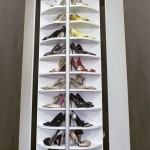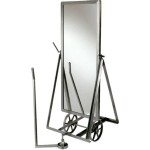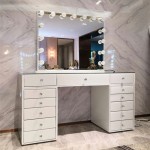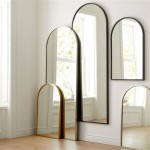How To Make A Backlit Vanity Mirror
A backlit vanity mirror adds a touch of elegance and functionality to any bathroom or dressing area. The soft, diffused light eliminates harsh shadows, providing optimal illumination for makeup application, grooming, and other personal care routines. Constructing a backlit vanity mirror is a manageable DIY project that can significantly enhance the aesthetic appeal and usability of a space. This article details the process, offering a comprehensive guide to creating a custom backlit vanity mirror.
Before embarking on the project, it is crucial to gather the necessary materials and tools. The specific requirements may vary depending on the desired size and style of the mirror, but the following list provides a general overview:
- Mirror: Select a mirror of the desired dimensions and thickness.
- Wood or MDF board: This serves as the backing for the mirror and provides a surface for mounting the LED strip lights.
- LED strip lights: Choose LED strip lights with a color temperature and brightness level that suits personal preference.
- Diffuser (optional): A diffuser, such as frosted acrylic or glass, can be used to soften the light and create a more even glow.
- Power supply: A suitable power supply is required to power the LED strip lights. Ensure the power supply is compatible with the voltage and wattage requirements of the LED strip lights.
- Wiring: Wire, wire connectors, and a switch are needed to connect the LED strip lights to the power supply.
- Mounting hardware: Screws, brackets, or other mounting hardware are required to securely attach the mirror to the wall.
- Tools: A measuring tape, pencil, saw, drill, screwdriver, wire stripper, soldering iron (optional), and safety glasses are essential tools for this project.
Safety precautions should be prioritized throughout the project. Always disconnect the power supply before working with electrical components. Wear safety glasses to protect eyes from debris. When using power tools, follow the manufacturer's instructions and wear appropriate personal protective equipment.
Key Point 1: Preparing the Backing Board
The backing board provides the structural foundation for the backlit vanity mirror. It must be cut to the appropriate size and prepared to accommodate the mirror and LED strip lights.
First, measure the dimensions of the mirror. The backing board should be slightly larger than the mirror, typically extending a few inches on each side to create a frame or allow for a recessed lighting effect. Mark the desired dimensions on the wood or MDF board using a measuring tape and pencil. Use a saw to cut the board to the marked dimensions. Ensure the cut is straight and accurate for a professional-looking finish.
Next, create a recess or channel on the back of the board to house the LED strip lights. This can be achieved using a router or by carefully chiseling out the desired area. The depth and width of the recess will depend on the size and type of LED strip lights being used. The recess should be deep enough to accommodate the LED strip lights and any associated wiring, while still allowing the mirror to sit flush against the front of the board.
Consider the routing of the wiring. Create a small channel or hole to allow the wiring to pass from the LED strip lights to the power supply. This will help to conceal the wiring and create a cleaner, more organized appearance. Sand the edges of the backing board to remove any sharp edges or splinters. This will improve the safety and aesthetic appeal of the finished mirror.
If a diffuser is being used, consider how it will be attached to the backing board. The diffuser can be mounted directly to the board or suspended slightly above the LED strip lights. This will affect the placement of the LED strip lights and the design of the recess.
Key Point 2: Installing the LED Strip Lights
The installation of the LED strip lights is a critical step in creating a functional and aesthetically pleasing backlit vanity mirror. Proper placement and wiring of the lights are essential for achieving the desired lighting effect.
Begin by planning the layout of the LED strip lights within the recess on the back of the backing board. The LED strip lights can be arranged in a continuous loop around the perimeter of the mirror, or they can be placed in a grid pattern to provide more even illumination. Consider the spacing between the LED strip lights and the diffuser (if used) to achieve the optimal light distribution. Test the layout by temporarily positioning the LED strip lights and observing the resulting light output. Adjust the placement as needed to achieve the desired effect.
Once the layout has been finalized, carefully adhere the LED strip lights to the backing board using the adhesive backing provided on the strips. Ensure the strips are securely attached and that there are no loose or dangling sections. If the adhesive is not sufficient, consider using additional adhesive, such as double-sided tape or a small amount of glue. Be mindful of the polarity (+ and -) of the LED strip lights. The power supply must be connected to the LED strip lights with the correct polarity to ensure proper operation. Refer to the instructions provided with the LED strip lights and power supply for specific wiring instructions.
Connect the LED strip lights to the power supply using appropriate wiring and connectors. Use wire strippers to expose the ends of the wires and wire connectors to create a secure connection. Solder the connections for a more robust and permanent bond. If soldering is not an option, use crimp connectors or other suitable wiring connectors. Ensure all connections are properly insulated to prevent short circuits or electrical hazards. Use electrical tape or heat shrink tubing to insulate the connections.
Install an optional switch to control the LED strip lights. The switch can be mounted on the backing board or on a nearby wall. Connect the switch to the power supply and the LED strip lights according to the manufacturer's instructions. Test the wiring by connecting the power supply and turning on the switch. Verify that the LED strip lights are functioning correctly and that there are no shorts or other electrical issues.
Key Point 3: Assembling and Mounting the Mirror
The final step in creating a backlit vanity mirror involves assembling the components and mounting the finished mirror to the wall. This requires careful attention to detail and adherence to safety precautions.
Carefully position the mirror on the front of the backing board. Ensure the mirror is centered and aligned correctly. Secure the mirror to the backing board using appropriate adhesive, such as mirror mastic or silicone adhesive. Apply the adhesive evenly to the back of the mirror and press it firmly against the backing board. Allow the adhesive to cure completely according to the manufacturer's instructions. This may take several hours or even overnight. Use clamps or weights to hold the mirror in place while the adhesive is curing. Be careful not to scratch or damage the mirror surface.
If a diffuser is being used, attach it to the front of the backing board, covering the LED strip lights. The diffuser can be attached using screws, clips, or adhesive. Ensure the diffuser is securely attached and that it covers the LED strip lights completely. The diffuser should be flush with the edges of the mirror or slightly recessed to create a clean, professional look.
Select appropriate mounting hardware to securely attach the mirror to the wall. The type of mounting hardware will depend on the weight of the mirror and the type of wall construction. Consider using heavy-duty screws, brackets, or a French cleat system. Locate the wall studs using a stud finder. The mounting hardware should be anchored to the wall studs for maximum stability. Mark the location of the mounting holes on the wall and drill pilot holes. Align the mirror with the pilot holes and securely attach it to the wall using the appropriate mounting hardware. Ensure the mirror is level and plumb before tightening the screws.
Connect the power supply to a suitable electrical outlet. Ensure the outlet is properly grounded and that it meets the electrical requirements of the power supply. Conceal the wiring as much as possible to create a clean and professional appearance. Use wire clips or cable ties to keep the wiring organized and out of sight. Test the finished mirror by turning on the power supply and the switch. Verify that the LED strip lights are functioning correctly and that the mirror is securely mounted to the wall. Make any necessary adjustments to the mounting hardware or wiring to ensure the mirror is safe and secure.
Thorough testing and inspection of all connections are vital. Check for any loose wires, exposed connections, or potential hazards. Address any issues immediately to ensure the safety and longevity of the backlit vanity mirror. The finished product should provide even, diffused lighting that enhances the functionality and aesthetic appeal of the space.

How To Diy Vanity Mirror With Led Strip Lights

25 Beautiful Diy Vanity Mirror That Is Easy And To Do Most Of This Projects Can Be Done Un Bathroom Makeover Design Mirrors

How To Diy Vanity Mirror With Led Strip Lights

Diy Vanity Mirror W Led Lights And Easy Tesiabeau

Diy Floating Glowing Mirror

Diy Light Up Vanity Mirrors You Can Make Ohmeohmy Blog

Diy Vanity Mirror W Led Lights And Easy Tesiabeau

Bathroom Remodel Diy Backlit Mirror Leah And Joe Home Projects Crafts

Diy Vanity Mirror With Lighted Frame Led Bathroom Remodel

Diy Led Light Strips For Mirror Practical Advice Nakashi Lighting








